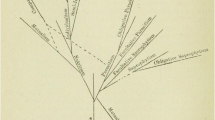Abstract
When new entities are formed by the integration of individual organisms, these new entities possess characteristics which go beyond the sum of the individual properties of each element of the association, resulting in the development of new attributes and capacities as an integrated whole. In this process, these new entities also agglutinate and dynamize synergies not present in the individual organisms. In this sense, evolution is a dynamic process that evolves not in the way of perfection or progress, but in the way of adaptation to new conditions. Symbiogenesis, as an evolutionary mechanism, allows a coherent conceptual rupture with some evolutionary ideas of the past and, at the same time, shows and builds a new approach to life, based on solid evolutionary ideas, expanding evolution to an adequate level of integration with the more recent data in biology. These ideas and concepts should be integrated in a post-neodarwinian approach to evolution that needs further attention from the scientific community. The development of a Symbiogenic Theory of Evolution could contribute toward a new epistemological approach of the symbiotic phenomenon in the evolutionary context. This, in our point of view, could be the beginning of a new paradigm in science that rests almost unexplored.

Similar content being viewed by others
References
Bouchard F (2007) What is a symbiotic superorganism and how do you measure its fitness? Abstracts of the ISHPSSB Meeting, University of Exeter, UK, July 25–29, 45 pp
Braun-Howland EB, Nierzwicki-Bauer SA (1990) Azolla-Anabaena symbiosis: biochemistry, physiology, ultrastructure, and molecular biology. In: Rai AN (ed) CRC handbook of symbiotic cyanobacteria. CRC Press, Boca Raton, pp 65–117
Carrapiço F (2002) The Azolla-Anabaena-bacteria system as a natural microcosm. Proc SPIE 4495:261–265
Carrapiço F (2006) Is the Azolla-Anabaena symbiosis a co-evolution case? In: Sitnykov A (ed) General botany: traditions and perspectives. Book of international conference dedicated to 200th anniversary of the Kazan Botanical School. Part I, Kazan, pp 193–195
Carrapiço F (2010) Azolla as a superorganism. Its implication in symbiotic studies. In: Seckbach J, Grube M (eds) Symbioses and stress. Springer, Berlin
Corning PA (2005) Holistic Darwinism. Synergies, cybernetics, and the bioeconomics of evolution. The University of Chicago Press, Chicago
De Bary A (1878) Ueber symbiose—Tageblatt 51 Versamml. Deutscher Naturforscher u. Aerzte, Cassel, pp 121–126
Douglas AE (1994) Symbiotic interactions. Oxford University Press, Oxford
Douglas AE (2010) The symbiotic habit. Princeton University Press, Princeton, NJ
Dubos R, Kessler A (1963) Integrative and disintegrative factors in symbiotic associations. In: Nutman PS, Mosse B (eds) Proceedings of the thirteenth symposium of the society for general microbiology, London, pp 1–11
Gontier N (2007) Universal symbiogenesis: an alternative to universal selectionist accounts of evolution. Symbiosis 44:167–181
Grilli Caiola M, Forni C (1999) The hard life of prokaryotes in the leaf cavities of Azolla. In: Seckbach J (ed) Enigmatic microorganisms and life in extreme environments. Kluwer Academic Publishers, Dordrecht, The Netherlands, pp 629–639
Honegger R (2000) Simon Schwendener (1829–1919) and the dual hypothesis of lichens. Bryologist 103:167–183
Margulis L, Sagan D (2002) Acquiring genomes. A theory of the origins of species. Basic Books, New York
Merezhkowsky C (1909) The theory of two plasmas as foundation of symbiogenesis. A new doctrine on the origins of organisms. Proceedings of studies of the Imperial Kazan University, vol 12, pp 1–102. Publ. Office Imp. Univ. (in Russian)
Nylander W (1896) Les lichens des environs de Paris. Typographie Paul Schmidt, Paris
Papaefthimiou D, Van Hove C, Lejeune A, Rasmussen U, Wilmotte A (2008) Diversity and host specificity of Azolla cyanobionts. J Phycol 44:60–70
Roossinck MJ (2008) Symbiosis, mutualism and symbiogenesis. In: Evolution of plant virus. Springer, Berlin, pp 157–164
Rumpho ME, Worful JM, Lee J, Kannan K, Tyler MS, Bhattacharya D, Moustafa A, Manhart JR (2008) Horizontal gene transfer of the algal nuclear gene psbO to the photosynthetic sea slug Elysia chlorotica. PNAS 105(46):17867–17871
Sapp J (2003) Genesis: the evolution of life. Oxford University Press, New York
Sapp J (2004) The dynamics of symbiosis: an historical overview. Can J Bot 82:1046–1056
Sapp J (2009) The new foundations of evolution. On the tree of life. Oxford University Press, New York
Sapp J, Carrapiço F, Zolotonosov M (2002) Symbiogenesis: the hidden face of Constantin Merezhkowsky. Hist Phil Life Sci 24:413–440
Uheda E (1986) Isolation of hair cells from Azolla filiculoides var. japonica leaves. Plant. Cell Physiol 27(7):1255–1261
Villarreal LP (2005) Viruses and the evolution of life. ASM Press, Washington
Zook D (1998) A new symbiosis language. ISS Symbiosis News 1(3):1–3
Acknowledgments
I am grateful to Nathalie Gontier and Maria Helena Costa for the encouragement in the development of this work and to Helena Carrapiço for the English revision of the text.
Author information
Authors and Affiliations
Corresponding author
Rights and permissions
About this article
Cite this article
Carrapiço, F. How symbiogenic is evolution?. Theory Biosci. 129, 135–139 (2010). https://doi.org/10.1007/s12064-010-0100-1
Received:
Accepted:
Published:
Issue Date:
DOI: https://doi.org/10.1007/s12064-010-0100-1




